The following biographies and photos of the University of New Brunswick alumni who made the ultimate sacrifice during the First World War were taken (all text verbatim, but edited for grammar and spelling) from the Memorial Magazine 1914-1919, University of New Brunswick, published by the university in 1919.
The UNB Associated Alumni has established this website to put faces to the names of most of the 32 UNB alumni who gave their lives during the 'Great War.' A photo of only one of these soldiers is missing.
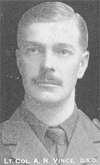
Lt.-Col. A. Neville Vince was born at Grafton, N.B., on July 19, 1879. He was the son of Lt.-Col. D. McLeod Vince and Milicent A. Vince. He graduated from Woodstock High School in 1894 and entered the University of New Brunswick in the autumn of the same year. He graduated in 1898 with honours in mathematics and mathematical physics. Later he took a course at Kingston Military School. He was a veteran of the South African War, having taken part in various operations in the Transvaal from December 1901 to May 31, 1902. He received the Queen's medal with five clasps. He continued in the Imperial Army until 1909, when he resigned. During this period of service, he was stationed in Ireland, India and Burmah. He entered upon the study of law, graduating from the Boston Law School in the spring of 1911.
In August 1914, he volunteered for active service in the European War, leaving Woodstock for Valcartier on August 20. He went across as captain of a Nova Scotia regiment and subsequently joined his old regiment, the King's Liverpool. He was rapidly promoted to the rank of lieutenant-colonel, won the D.S.O. and was especially mentioned in dispatches. During the heavy German attack near St. Quentin on March 24, 1918, he was severely wounded. He was later reported as wounded and missing, and doubtless met his death at the head of his men attempting to stem the furious rush of the German masses. He was in every respect a true soldier and one of nature's noblemen.
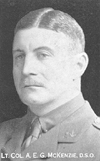
Lt.-Col. A. E. G. McKenzie, D.S.O., was the son of Archibald and Jean Elizabeth Smith McKenzie and was born in Campbellton, Restigouche Co., N.B., on January 21, 1878. Educated at the high school of his native town, he entered the university in 1898, graduated with a B.A. in 1902, and a master of arts degree in 1904. He later was given the degree B.C.L. by King's College in Nova Scotia.
For some time, he engaged in teaching, being principal of the Harkin's Academy in Newcastle, N.B., and the Albert School, Saint John, N.B. Admitted to the bar, he practiced law some years in Campbellton and took an active part in the public affairs of the county of Restigouche.
On the formation of the 26th N.B. Regiment in November, 1914, he enlisted as a major, having for many years held a captaincy in the militia and trained several summers. The 26th was located at Saint John during the winter of 1914-15, went overseas in June, and took up quarters at Sandling, near Hythe. In September it went to France and to the Ypres salient, where it participated in heavy fighting and won for itself the title of the "Fighting 26th."
Lt.-Col. McKenzie fought in the second battle of Ypres, at Courcelette, the Somme (1916), Vimy Ridge, Passchendaele, Amiens and Monchy. While leading his battalion he was killed at Cherisy, August 28, 1918.
For surpassing courage and gallantry in this action, he was recommended for a V. C. by General Ross.
Few officers participated in so many fierce struggles. Brave as a lion, cool in danger, quick and decisive in action, the tall, broad-shouldered and iron-muscled athlete was admired and loved by all. When he won the D. S. 0., he was spoken of by his superior officers as a noble type of soldier and one fearless in action.
He was buried in the Wan Court cemetery not far from the scene of his last fight.

Maj. John Hales Sweet was born in St. Mary's Rectory, Dalhousie, N.B., on October 13, 1878, the son of the Rev. J. H. and Evelina Janet Sweet, and was educated at the Harkin's Academy, Newcastle, Miramichi, where he had as a schoolfellow, Sir Max Aitken, now Baron Beaverbrook, and where he won the Governor-General's bronze medal three years in succession. He was matriculated at the University of New Brunswick and graduated in 1899 with a bachelor’s of art degree, the leader and valedictorian of his class. He was also editor of the University Monthly.
In the meantime, the family had moved to Victoria, B. C., and in1900, he began the study of law in the office of Tupper, Peters & Potts of that city, and was, in due time, called to the bar.
For a few years, he practiced his profession in Victoria, but in 1907, moved to Vancouver where he formed a partnership with Mr. Lambert Bond, under the title of Bond & Sweet.
His physical development was almost perfect. Tall, robust, athletic, fond of all kinds of outdoor sports, a leading canoeist and oarsman. He took an active part in the club activities of the two cities, while his genial disposition, unfailing cheerfulness and courage made him everywhere popular. He became a leader by force of ability to win and hold the confidence of all who knew him.
In 1915, he volunteered his services and obtained a commission as lieutenant in the 72nd (Seaforth Highlanders), being promoted soon after to a captaincy and then to the position of major. After a period of training the 72nd, he went overseas, and was located at Bramshott Camp for a time before crossing to France, where Major Sweet saw active service for some months, especially in the long drawn out battle of the Somme.
His personal and soldierly qualities soon brought him into the limelight, and he was chosen, with twelve other overseas officers, to return to Aldershot to enter upon a course of training for higher positions in the army, with a class which comprised one hundred and fifty Imperial Army officers — a flattering distinction to the young Canadian soldier.
About the middle of January, 1917, he rejoined his old regiment on the Somme. He was killed in action on Easter Monday, April 9, in the bloody battle of Vimy Ridge. Shortly after the attack was launched, Maj. Sweet was wounded in the arm, and to one advising him to return to the dressing station the young officer replied, "No, I am going on with my men." He had reached the German first-line trench, and, while standing on the parapet waving his men on, was hit by shrapnel and instantly killed.
A man's real character and worth become best known to those who are closely associated with him in sunshine and storm. A sergeant of his company says, "We were all very sorry to lose such a brave man and so fine an officer. His bright and cheerful manner and his bravery won the admiration of every man and officer."
Gen. Sir Arthur Currie: "In the Vimy fighting I also lost another old and dear friend, Jack Sweet . . . . He was regarded by all as an officer of outstanding promise."
A third officer writes: "I cannot tell you how much the loss of Major Sweet means to his battalion and especially to his brother officers. He was always a source of inspiration to us, and many times, when conditions were very trying, he, by one of his many jokes and cheery smiles, would cheer everyone up."
His remains lie in the military cemetery at Villers au Bois, marked by a cross, and only three miles from Vimy Ridge, which he and his gallant comrades stormed, and from which they swept the German hosts in one of the greatest battles the world ever knew.
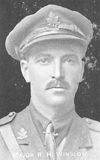
Maj. Rainsford Hannay Winslow entered the University of New Brunswick as a freshman in the fall of 1904.
He was born in Fredericton, N.B., on October 19, 1887, being the youngest son of the late E. Byron Winslow, K. C.
In 1906, after completing his sophomore year at UNB, he entered the sophomore class at McGill College, taking a course in applied science, and graduated from there in 1909 with a bachelor of science degree in mining engineering.
After leaving McGill, Maj. Winslow was employed for about a year as an assayer at Cobalt and later settled in British Columbia, where he was appointed a provincial assayer and land surveyor. He was also a member of the Canadian Society of Civil Engineers.
When war broke out, he was employed on the Harbour Commission at Vancouver, and was desirous of enlisting as a private in the battalion being organized in New Brunswick for overseas service, but was specially requested by the Harbour Commission to remain at that work for a few months longer.
In December, 1914, he obtained a commission as lieutenant in the 48th Battalion, Canadian Expeditionary Forces, and went with the battalion to England. Later on, this unit was transformed into the 3rd Pioneer Battalion and was sent to France in March, 1916.
He received his first promotion to a captaincy on July 22, 1916. On September 22, 1916, he was wounded over the eye by a piece of shrapnel but after having his wound dressed returned to his work. Later on the same day, he was again wounded by shrapnel. Both of these wounds were slight, and Capt. Winslow remained with his regiment until it was disbanded in 1917.
He then became an instructor in the Canadian Corps Training School, and was afterwards on the staff of the 2nd Brigade, First Canadian Division.
In 1918, he was promoted to the rank of major and given command of No.1 Company, Canadian Corps Tramways. There were about 800 men in this command and the work of the corps was more than once highly commended.
On September 3, 1918, he rejoined his company after a month's leave in England, and on the evening of September 5, he was wounded by a shell on the Arras-Cambrai road near Villers-les-Gagnicourt, and died at No. 7 Casualty Clearing Station on September 9. He was buried at Ligny St. Flochel, near St. Pol, Pas de Calais.
Gen. Currie wrote of him as follows: "He was a most valued officer in our Tramways Department. I knew him quite well. All the engineers and infantry with whom he served spoke of him in the highest possible terms of praise."
Maj. Winslow was the second of his family to die in the Great War, an older brother, Lieut. J. A. Winslow, having died in France on March 22, 1917. Another brother, Capt. R. N. Winslow, (UNB'06), is in France with the 310th Engineers American Expeditionary Forces.
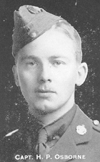
Capt. Hubert Patterson Osborne, the eldest son of Lieut.-Col. William J. and Evelyn Beatrice (Phippen) Osborne, was born at Belleville, ON, on April 28, 1895, being of Loyalist descent. His early education was obtained at the Fredericton public schools, Mt. Allison Academy and Fredericton Business College. He started at UNB in 1911 and was enrolled for three years. Later, Capt. Osborne was a student at Osgoode Hall, Toronto, and at the time of his enlistment was a student-at-law in the offices of McCarthy, Osler, Hoskin and Harcourt, of Toronto.
Capt. Osborne's military career is a long and creditable one, and he has well maintained the traditions of his family. He enlisted as a bugler in June, 1907, with the 71st York Regiment, and was gazetted as a lieutenant in the same unit in 1914. In September, 1915, he was appointed a lieutenant in "C" Company, 104th Battalion, and later was promoted to second in command of his company with the rank of captain. He reached England with this unit in June, 1916, and, on the unit being broken up into drafts, transferred to the Royal Flying Corps. After doing duty as an observer on Coast Defence in England, he went to France with the 21st Squadron in July, 1917. On August 7, 1917, he was instantly killed by machine gun bullets in a fight with four German planes. He was buried in Perth Cemetery, Zillebeke. The bereaved family has had numerous letters from comrades of the gallant officer testifying to his worth and happy disposition. His father has seen service in France, and also his younger brother, Gordon. His chaplain had suggested this epitaph:
In honour chivalrous;
In duty valorous;
In all things noble;
To the heart's core, clean.
The following lines aptly describe the spirit of this gallant soldier:
"All that life contains of torture, toil and treason
Shame, dishonour, death, to him were but a name.
Here a boy he dwelt through all the singing season,
And ere the day of sorrow, departed as he came."
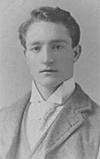
Ralph Markham entered the class of 1898, coming from Saint John, N.B. He is remembered by the students of 20 years ago as one of the best football backs on the university team. He left the university after attending for two years. Later the family moved to Vancouver. Markham went overseas as a captain in one of the western battalions and was killed in action early in the war. Those who knew him in the old days do not need to be told that his career was an honourable one, and that he proved himself an energetic and capable officer.
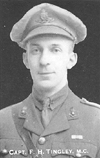
Frank Harvey Tingley, the son of Mr. and Mrs. A. J. Tingley, of Moncton, N.B., was born at Point de Bute, Westmorland County, N. B., February 10, 1890. He received his early education in the public schools of this province and entered the university on graduating from Aberdeen High School, Moncton, in 1906. At the university, although reserved and modest in manner, he was interested in all student activities. He was a talented pianist and an enthusiastic member of the College Glee Club. He received his bachelor of science in engineering degree in 1910. After graduating he was employed as a civil engineer for the public works department.
Before the war, he held a commission as lieutenant in the old 19th Field Battery of the militia. Upon the outbreak of war, he immediately offered his services. His old battery volunteered and became the 3rd Field Battery, Canadian Expeditionary Forces. He crossed to England as a lieutenant in the 8th Battery with the First Contingent in November 1914. His battery went to France in February 1915. At Ypres, on May 2, 1915, while acting as a forward observing officer for his battery, he was wounded in the knee. For his distinguished services on this occasion, he was awarded the Military Cross. As his wound was somewhat slow in healing he was sent to Canada while convalescing. On his arrival at Moncton in the summer of 1915, he was accorded an enthusiastic reception by the citizens of his home city. He returned to the front in January 1916. On August 18 of that same year, he was wounded a second time and again returned to Canada. His spirit and belief in the cause are shown in that he now refused a staff position in Canada, and requested to be allowed to return to the front. While in Canada, he was commissioned to recruit an artillery draft.
After raising and training his men in Canada, he returned overseas with his men in November 1917. He was promoted to the rank of captain in the 36th Battery on his return to the front. Later he was transferred to the 23rd Battery. While with this battery, on September 5, 1918, he was severely wounded by an aeroplane bomb. Although severely wounded, hopes were entertained for his recovery, therefore news of his death on October 14, 1918, came somewhat unexpectedly. Capt. Tingley was well liked by all, and his many friends, both in military and civil life, will keenly regret his loss.
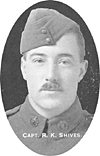
Capt. Robert Kilgour Shives was born at Campbellton, Restigouche County, N.B., on July 20, 1891, and was the son of the late Kilgour and Maria S. Shives. His father, a prominent lumber merchant, lost his life, while hunting big game, by the accidental discharge of a rifle.
He was educated at the Campbellton Grammar School, matriculated into the forestry department of UNB in 1909, and graduated in 1913.
He volunteered in 1914, but was not accepted because of a weak ankle, the result of an accident shortly before, while engaged in forestry work near Grand Falls, N.B. But, not to be hindered from doing his ‘bit’, the young man proceeded to Toronto and took a course in aviation with the Curtis Firm, qualifying for a position in the Imperial Army. Shortly after his arrival in England, he was sent to the Ypres salient, where his efficient and valuable service as pilot and observer won him a rapid promotion from second lieutenant to a Lieutenancy, and finally, he was made Captain in charge of a flight of six machines.
His photographs of positions taken while on scout duty were remarkably clear and full, and stamped him as a born artist. One, taken on the eve of a projected advance, revealed a Hun trench unknown to the British officer, which would have wrought havoc in the attacking lines on the morrow. It was promptly demolished, and the young officer and scout was commended for his excellent work. On Sunday, April 30, 1916, and while flying ten miles back of the German lines, he engaged an enemy machine, and was badly wounded, but brought his air-ship back in safety to the aerodrome, 25 miles distant.
Invalided to England and recovering from the wound, he visited his home in the summer of the same year. He returned overseas and went on Zeppelin duty in August, but was accidentally killed at Euston, near Thetford, September 29, 1916, by the discharge of a machine gun he was examining.
With the permission of the Home Secretary, the remains were removed from Euston, brought to New Brunswick and re-interred in Fernhill Cemetery in Saint John.
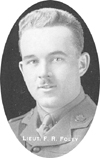
Lieut. Fred R. Foley, the only son of Mr. and Mrs. F. L. Foley, was born in Saint John, N.B., on August 2, 1893. His early education was obtained in the public schools of that city and he graduated from high school in 1912. For two years subsequently, he worked with his father in the pottery firm of Jas. W. Foley & Co. He entered UNB in September 1914, but duty's call enabled him to complete only one term's work. All through his high school and his short college career, lieutenant Foley was very prominent in athletics, and the family are in proud possession of many medals that testify to his prowess.
Early in 1915, he enlisted in the Field Artillery, and later went to Fredericton and qualified for a commission in the infantry. He was then attached to the 55th Battalion and went with that unit from Sussex to Valcartier and thence to England in the fall of 1915. On July 1, 1916, he went in a draft to France to fill up the depleted ranks of the 26th New Brunswick Battalion. His military career was one of great promise, but unfortunately, it was cut short by his death on September 30, 1916, during the battle of the Somme. With two other officers, Lt. Foley was sleeping in a German dugout when a German shell made a direct hit upon it and he was instantly killed. He was buried in the little village of Comcelette.
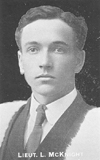
Lt. Locksley McKnight, the son of John and Katherine McKnight, of Fredericton, N.B., was born in that city on December 30, 1888. His early education was received in the Fredericton public schools and he entered the university in 1905. He was a brilliant student and an athlete of great ability. He was a member of the best basketball team the university ever had and he was also a star at football.
Lt. McKnight graduated with a bachelor of arts degree in 1909. For a year he was principal of the Andover Grammar School and then returned to the university for the year 1910-11. He received his master of arts degree, and later became principal of the McCauley School in Edmonton, A.B. He took further courses at the University of Alberta, and Columbia University, New York.
He received his commission with the 56th Calgary Battalion on October 15, 1915, and went overseas on April 10, 1916. He volunteered to take a draft of the 49th Battalion to France in June of that year and was attached to that unit at the time of his death, which occurred at Courcelette. Of his death a fellow-officer writes as follows: "At the last moment, he, along with some other officers, was selected to remain behind as a reserve. Next afternoon, when they learned at headquarters that four out of five officers of "D" Company were wounded, and that I was the only officer left and had been slightly wounded, they sent Locksley and another officer to help me out. We were in a somewhat isolated position and they had to come across an open space for a short distance. They had just started, when a German machine gun opened on them, killing them both."
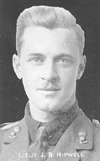
Lt. Jack Basil Hipwell, the elder son of Mr. and Mrs. David Hipwell was born in 1893 in the Town of Woodstock, N. B., where he lived with his family until the age of 14, when the family moved to Saint John, N.B., where Lt. Hipwell finished his high school education. His school career was always brilliant. He led Carleton County on entrance into high school and won several medals throughout his course, including the Dominion Medal for Manual Training work.
Lt. Hipwell was a member of the 1915 Forestry Class, and was granted his degree by the university, together with other members of his class who enlisted in the 23rd Battery, Canadian Field Artillery, during the winter of 1914-1915. Besides being well to the front in his studies, he held various offices, including the following: member of the class and university hockey and basketball teams; secretary-treasurer and vice-president Forestry Association; class president and member of the debating team; senior editor of the Monthly and president of the Students' Association.
Lt. Hipwell crossed to England in February, 1915. To get to France the more quickly, he gave up his stripes and reverted to the ranks. He went to France in May, 1915, and was soon drafted into the 8th Battery, with which he served until April, 1916, when he was granted a commission. After a remarkably short and successful course of seven weeks at Shorncliffe, Lt. Hipwell returned to France.
His fatal wounds were received just two weeks after his return to the front on duty with the 5th Battery, during the allied bombardment as an initial move to the attack of Sanctuary Wood, on June 17, 1916. "Tell the Major I was on the job," was the last message of this gallant officer to his officer commanding, as he lay dying in a rude dugout in the Ypres salient. Thus Jack Hipwell died as he had lived. His brother Harry is now on duty overseas. Besides his parents and brother, he is survived by two sisters, Mary and Annie Hipwell.

Lt. John T. Gibson was the son of Alexander and Charlotte Gibson, and was born at Marysville, York County, N. B. on February 28, 1890.
He was educated in the Marysville School and the Fredericton High School, and was matriculated into the university, where he entered the department of civil engineering. In 1910, he was graduated, and accepted a position in the Dominion Public Works Department, Saint John, N.B.
As early as 1906, he became a member of the 71st Regiment and drilled more or less regularly for some years, winning a lieutenancy in 1916, when he enlisted. In September, he was appointed recruiting officer for the counties of Kings and Sunbury, which position he filled until January, 1917, and in June of that year, he was granted a cadetship in the Royal Flying Corps, and soon after obtained a lieutenancy.
He sailed for England on September 1, 1917, with a detachment of the Canadian Air Force, passed all the tests successfully, and was assigned to duty at Gatesbury, Wiltshire. While making a ‘solo’ flight, his plane in some way got out of control and crashed to the ground, fatally injuring the young aviator, who never recovered consciousness, dying on February 10, shortly after the accident. He was buried with military honours in a little churchyard at that place.
He was fond of military life. Those, who knew him best, admired his sturdy, heroic spirit, and were looking for a record of iron courage and brave deeds, had the young soldier been destined to reach the line where men do and die; but it was otherwise ordained.

Lt. Ralph B. Clark was the son of William and Ruth Clark, of St. Stephen, N. B., where he was born on July 27, 1889. He matriculated from the high school of the town into the university, and was graduated in 1911 with a bachelor of arts degree.
During his undergraduate course, he took a prominent part in Y.M.C.A. activities, and was untiring in his zeal to promote the social and moral well-being of the students. His love and genius for the work found recognition; for in the fall of 1911, he was appointed by the Presbyterian Church to a position in Naparima College, Trinidad, where he remained for two years. On his return, he entered Pine Hill Theological College, in Halifax, N.S., but, when the great war broke out, he was among the first to volunteer, and enlisted as a private in the Army Medical Corps. In February, 1915, he went overseas, and remained in England until May, when he crossed to France with No.1 Canadian Hospital.
Ever sincere, conscientious in the discharge of his duties, and attentive to the wants and comforts of others, Private Clark became very popular among the staff and was promoted to corporal and afterwards to sergeant. One year was passed in hospital work; but the ghastly scenes of the dressing stations, with their story of great deeds being done and tremendous sacrifices made at the front, stirred the deep sense of a higher duty, and he applied for permission to join a combatant unit. The request being granted, he was made a lieutenant and returned to England, where he was attached to the 12th Battalion, and saw some months' training. Returning to France, he joined the 26th - the ‘Fighting 26th’ - which took a prominent part in the great offensive of the Somme and later at Courcelette, where Lt. Clark was killed on September 17.
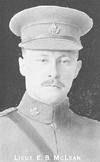
Edward Byron McLean, son of the late K. A. and Mary McLean, was born in Moncton, N.B., on June 13, 1887.
He received his early education in the Moncton schools, graduating from Aberdeen High School in 1903. The same year, he entered UNB, graduating with a bachelor of science degree in 1907. He received a master of science degree in 1910.
Until 1912, he was with the Canadian Government Railways as an engineer. He then went to Calgary, A.B., where he was employed first with the Canadian Pacific Railway and later as assistant city engineer of Calgary.
He enlisted in June, 1915, as a lieutenant in A. Company of the 50th Overseas Battalion. In October of that year, he went to England and left for Belgium on August 8, and then to France on September 5, 1916. He fought at Ypres and the Battle of the Somme. During the taking of Regina trench at the Somme, on November 18, A. Company went beyond its objective. The major, in attempting to recall his men, was shot by a sniper. McLean took command, and shortly afterward, in going to the aid of one of his men, was shot through the head and instantly killed. The bodies of the officers were not recovered.
Lt. McLean is survived by a wife and two children.
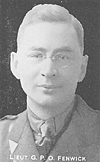
George Paget Owen Fenwick was born at Apohaqui, Kings County, N.B., on August 18, 1882. He was the youngest son of Matthew Fenwick and Harriet Owen Fenwick. He attended the school at Apohaqui and the Sussex Grammar School, from which he graduated in 1898. In the fall of that year, he entered UNB, holding the Kings County Scholarship. He graduated from in1902 with first-class honours in natural science and Chemistry. For the next two years, he took post-graduate work in chemistry and natural science at Queens University. The following year, he spent at Wesleyan University, Middletown, Conn., U.S.A., as an assistant in chemistry.
On account of the sudden death of his father, he was unable to return to Wesleyan University. He successfully wrote the Provincial Grammar School License examinations, and became the principal of Dorchester High School. After two years, he resigned and entered the Dalhousie Law School. In 1911, he received a bachelor of civil laws degree, being graduated as the leader of his class. During the fall of that year, he wrote the New Brunswick Bar examinations and was admitted to the bar at the head of the list. He was offered and accepted a position in the Department of the Attorney General of Alberta, where later he became solicitor to the attorney general.
He enlisted and received a commission with the 115th Battalion, but was unable to leave his department at the time of his enlistment. He joined the unit at Bramshott, England, on August 19, 1916. When this unit was broken up, he was attached to the 112th Battalion, but was soon transferred to the Machine Gun Corps. His military training was taken at Pirbright and Crowborough. He went to France with the 7th Machine Gun Company in May, 1917. In August of that year, he conducted the provincial overseas elections for the Province of Alberta. He was killed in action at Passchendaele on October 30, 1917.
Of Lt. Fenwick, his commanding officer wrote: "We were all very much affected by the death of Mr. Fenwick, for he was so keen, full of enthusiasm and a most likeable man. As he was in civil life prominent in his profession, so he was out here a most efficient and courageous officer. He was always thorough, and everything that was given him to do was done well and in a most cheerful spirit . . . The army has lost one of the kind we can ill afford to lose.

Charles Murray Lawson, of Loyalist descent, was born in Saint John, N.B., on August 19, 1883, the son of William and Julia Lawson. He was educated at the Saint John High School and UNB, graduating from the university with first-class honours in 1903. After graduation, he engaged in teaching. He taught at Rothesay Collegiate School, Western Canada College, Sussex Grammar School, Fredericton High School and Saint John High School. On his enlistment, he was granted leave of absence from the Saint John staff.
He was, before the war, a Lieutenant in the 62nd Fusiliers, and, shortly after the outbreak of the war, he received his commission as Lieutenant in the well-known 26th New Brunswick Battalion. He went to France in September, 1915, and was killed on the night of November 26, 1915, while making a reconnaissance in No Man's Land, for which duty he had volunteered.
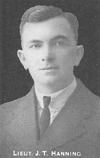
James Talmage Hanning, son of the late James Hanning and Jane McElveny Hanning, was born at Fredericton on February 15, 1887.
He was educated at the Fredericton High School and the University of New Brunswick. He became a qualified Civil Engineer and Deputy Land Surveyor. He followed his profession for eight years, five years being spent with Mr. G. G. Murdoch in Saint John.
He declined a commission with the Canadian Engineers and paid his own expenses to England to join the Royal Flying Corps, January l5, 1916. He obtained the rank of Second Lieutenant.
He was actively engaged in artillery observation and reconnaissance work during all the heavy fighting on the Somme in 1916.
On November 27, while endeavouring to carry out a reconnaissance at a very low altitude, his machine was shot down in flames by machine-gun fire from the ground and fell within the German lines.
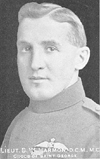
Burdette W. Harmon was born at Peel, N. B., on April 3, 1888, his parents being Allison W. Harmon and Louisa Harmon. He came to the University of New Brunswick with a High School training received at Woodstock, and was graduated in 1912 with the degree of B. A. After graduation, he was appointed Assistant Inspector of Fish Hatcheries with the Dominion Government, and was engaged in this work at the outbreak of the war. He first enlisted as a private with the Canadian Engineers, but had several transfers, the first to the Imperial Army with the West Yorkshires, then to the 52nd Battalion in a Manitoba regiment, and finally to the Royal Flying Corps with the rank of lieutenant.
He holds a very honourable place among our heroes, being the winner of three medals, - .C.M., M.C., and Cross of St. George. Lieutenant Harmon did his part at Ypres 1915, Festubert 1915, Givenchy 1915, Ypres 1916, Somme 1916, Vimy 1917, Cambrai 1917, Amiens 1918. He was shot down while on patrol duty, east of Corbie on May 10, 1918.
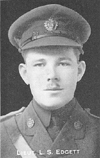
Louis Stanley Edgett was the son of the late Captain Judson H. Edgett and Mrs. Annie B. Steeves of Hillsborough, New Brunswick, and was born on the ship "Stanley," of which his father was the captain, on the Indian Ocean, June 23, 1894, near Port Louis, Island of Mauritius, from which city and ship he took his Christian names. Two years later, in March, 1896, the ship "Stanley" was lost in a hurricane in the North Sea, off the coast of Holland, and after clinging to the rigging from 4 p.m. till 9 o'clock next morning, the child, his parents and a part of the crew were rescued by a lifeboat and landed at Nieuwediep.
He received his preparatory education in the Hillsborough High School, where he graduated at the head of his class in June, 1912, and entered the University of New Brunswick in September of that year, being awarded the Albert County Scholarship. But he was not destined to complete his University course, for the call to arms in defence of outraged justice and humanity met a ready response in the youthful student of strong friendships, broad sympathies and heroic mould, and "Stan" put aside the college gown and donned the khaki in November, 1915. He had already seen considerable military training at Camp Sussex, first as a member of the 28th New Brunswick Dragoons, later of the 74th Westmorland Regiment (Brunswick Rangers), and subsequently qualified for Captain and Lieutenant at the Military School at Halifax.
After enlistment, he was attached to the Canadian Battalion (St. John Tigers) as musketry instructor, and in September, 1916, proceeded overseas. On arrival in England, he was transferred to the 60th Battalion Canadian Infantry (Victoria Rifles, Canada) as Lieutenant in "B" Company, and went immediately to France, where he saw several months of active service.
May 1, 1917, he was transferred to the 87th Battalion Canadian Infantry (Canadian Grenadier Guards), and nine days later was mortally wounded in the struggle before Lens, May 10. Though hurried to the emergency hospital and treated with all the care and skill possible, the young officer was so badly injured that he died the same day.
Lieutenant Edgett fought also at the Somme and in the bloody but victorious battle of Vimy Ridge, where the Canadian troops covered themselves with glory.
Energy, courage, and a spirit of self-sacrifice, combined with a cheerful bearing at all times, made him popular with officers and men. Lieutenant-Colonel J. O. Douchse, of the 87th, said: "We all feel his loss personally, and, although young, he had developed very soldierly qualities."
Major T. S. Ralston, of the 60th Battalion, with whom the young soldier had seen practically all his service in France, wrote: "In his time with us, he was looked upon as a most capable and efficient officer and one we could ill afford to lose."
Lord Stamfordham, at His Majesty the King's command, addressed his mother in these words: "The King has received from his Excellency, the Governor-General of Canada, an issue of the 'Moncton Times,' giving a sketch of the life of your son, Lieutenant Louis Stanley Edgett. The King was grieved to hear of the loss which you have sustained. His Majesty was interested in the fact that Lieutenant Edgett was born on the same day as the Prince of Wales, and to learn that he had gone through such thrilling experiences as a child of only two years of age. I am commanded to express to you the King's true sympathy in the fresh trial you are called upon to bear, but his Majesty hopes you may find some consolation in the thought that your gallant son sacrificed his life in the cause of justice and freedom."
In the military cemetery at Lapugnory, and within sight of the scene of his last fight, Lieutenant Edgett was laid to rest by his sorrowing comrades.
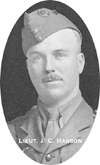
Lieutenant John C. Hanson was the only son of Inspector of Schools Rupert D. and Gussie P. Hanson, and was born in Sussex, N.B., in 1894. Educated at the Bathurst and Chatham Grammar Schools, where he distinguished himself, winning the Lieutenant-Governor's medal in the former, and the Governor-General's in the latter, he entered the University in 1909 and graduated with the degree of B. A. in 1913. During his undergraduate course, he was awarded the Alumni Gold Medal in Latin essay competition, and the Connaught Gold Medal for proficiency in Science.
He entered the profession of teaching and was Principal of the Riverside Consolidated School, when the call "To arms" went forth, and young Hanson, who had already had some military training and experience, first as Quartermaster Sergeant of the 71st Battalion, and later as Lieutenant of the 74th, enlisted, and went to England in June, 1917, as Lieutenant of "D" Company, l04th Battalion. There he attended different military schools, and on the conclusion of the course received a certificate of excellence in military law and strategy.
While at Hythe he witnessed a Hun air raid of which he wrote: "I counted sixteen planes myself; and some say there was a Zeppelin also, but I doubt it. I had my binoculars trained on them all the time, and the bombs were dropping around so thick and fast, I got dizzy trying to calculate where the next one would land. You could hear 'swish,' 'bang,' and knew you were safe from that one."
As a member of the Royal Flying Corps, he went to France and was attached to the 55th Squadron, June 10. The day before he had his photograph taken and ordered an ivory miniature for his mother, of which he wrote: "You can see that it is finished, if I don't." He seemed to be filled with a premonition of impending fate.
On scout duty, he frequently flew over the Hun lines, and the young aviator had some thrilling experiences on these occasions. Of one he wrote: "We steadily climbed until we reached 17,000 feet. The wind was westerly, but near the earth was very light. However, it must have been blowing quite hard upstairs. For when we came down through the clouds to see where we were, my pilot did not recognize the country at all . . . . Things looked rather plain at 2,000 feet and we could see several towns and villages and one large city on our left. We flew west. Suddenly I heard a sharp crump, crump, crump. The coal-black "Archies" were bursting all around me. An extra loud bang seemed to go right in my very ear.
"By this time the pilot was twisting the machine and throwing her about, so that I had to hold on for dear life. We were going 110 to 120 miles per hour, and, as we neared the trenches, the Huns turned their machine guns on us. I can't just describe my feelings. I suppose I was frightened. But I was also terribly interested . . . . All we had to show for it was a few machine gun bullets and shrapnel splinters through our wings and tail"
On July 13 his squadron participated in a battle which he described as terrible. Two members of the squadron went down, but the rest got some Hun fliers as compensation.
The morning of the 14th he and his pilot were ordered to "try out" a machine of the new type, which was dreaded by all the boys; and, after rising to some height, it suddenly lurched, nose-dived to the earth, and both pilot and observer were instantly killed.
Lieutenant Hanson was described by his commander as "a good officer and a stout companion." Active and adventurous, quick and decisive in action, he was a good type of Canadian youth, who volunteered when the safety of the Empire was threatened.
He and his trusty pilot, who had so often challenged death together in the dim heights above the clouds or amid the rattle of anti-aircraft guns and the bursting of shells as they swooped over the enemy's lines, lie side by side in the same grave in Souvenir Cemetery, Longuenesse, St. Omer.
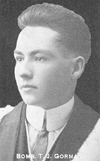
Bombardier Thomas J. Gorman was born at Saint John, N. B., April 23, 1892, his parents being Elizabeth T. and the late Thomas Gorman. He received his early education in the public schools of Saint John and then entered upon his collegiate course at St. Francis Xavier University, Antigonish, N. S. After remaining there for two years studying for his engineering degree, he accepted a position with the Public Works Department at Chatham as Assistant Engineer. In 1913, he entered the University of New Brunswick, and continued his engineering course until the outbreak of the war, when, with others of his class, he joined the 23rd Battery, mobilizing in Fredericton. At the Encaenia of 1915, he received his degree in absentia.
After brief periods of training in Canada and England, Bombardier Gorman was sent to France and was attached to the 8th Battery, Canadian Field Artillery. With this unit, he served through two years of intense fighting, - Festubert, Givenchy, Ypres, Sanctuary Wood, etc. At the battle of the Somme, Bombardier Gorman was instantly killed by a shell on October 12, 1916.
His military career was very conscientious and praiseworthy, so much so, that just previous to his death, he was detailed to proceed to England to study for a commission. His comrades speak very highly of him as a man and a soldier. He is survived by his mother and father, Elizabeth and Thomas Gorman, brothers Anglin, Harry and John, and sisters Genevieve, Elizabeth, Josie, Agatha and Kathleen, all of Saint John.

Bombardier John I. Morrison, the only son of Mr. and Mrs. Atwood Morrison, was born in Saint John, September 1, 1893. He received his early education in the public schools of Saint John and entered the University in the autumn of 1910. He had an enviable scholastic record all through his course and was very prominent in athletics. He was quiet and unassuming and possessed of dry humour, which would assert itself on occasion. His sterling traits gathered for him a large circle of friends. He completed his course in Civil Engineering at the age of twenty years.
Bombardier Morrison enlisted as early as August, 1914, with the 28th Dragoons, but, hearing they were not for active service, transferred in November to the 23rd Battery. He arrived in England the following February and went to the 2nd Brigade Artillery in France and to the 8th Field Battery. Later he was transferred to the 48th Howitzer Battery as a signaller, where his services were the admiration of both officers and men. He participated in the battles of the Somme, Givenchy, Sanctuary Wood, Vimy, Hill 70 and Passchendaele. He was lightly wounded in October, 1916, and was twice recommended for a decoration. The fatal wound was received at Passchendaele, November 30, 1917, and he died at the base hospital at Etaples on December 20.

Gunner Stewart Kitchen was the youngest son of Mr. and Mrs. Harry Kitchen, of Fredericton, N. B., where he was born February 20, 1895. His early education was obtained in the public schools of Fredericton, where he graduated from the High School in June, 1912. He entered the University the following autumn as a student in Forestry.
On December 2, 1914, he enlisted in the 23rd Battery, stationed in Fredericton, and on February 22, 1915, he sailed for England. He arrived in France in May of the same year and was attached to 5th Battery, Canadian Field Artillery, serving with this unit for nearly a year, when he was transferred to the D. 48th Howitzer Battery. It was while serving with this Battery that Gunner Kitchen met his death at the battle of the Somme. During a lull in the fighting on November 6, 1916, he and others started to repair their dugout, which shortly before had been hit by a shell. While they were so occupied, a shell hit the front of the dugout, killing Gunner Kitchen instantly. On November 10, he was laid to rest in the pretty Farahill Military Cemetery near Albert, close to the spot where he had fought so well. He was very popular with his comrades.

Signaller Jas Carleton Ketchum, the only son of Mr. and Mrs. T. Carleton Ketchum, Woodstock, received his early education in that town. He entered the University in 1911 in Arts, but shortly after changed his course to Forestry. Of a quiet, reserved disposition, and very unconventional, his originality and humour, joined with his natural ability, won him a coterie of warm friends among the students. He was particularly clever as an amateur artist, and in this capacity was a frequent contributor to "The Monthly." In the summer and fall of 1914, he was engaged in a forest survey on Duck Mountain Reserve, Manitoba. Having returned home, he enlisted with the 23rd Battery.
Sickness prevented him from reaching France as soon as he wished. Taking a special course in signalling, he was attached to the reorganized 22nd Battery in England, and when this Battery went to France, Signaller Ketchum was attached to the Headquarters' Staff, in which capacity he rendered valuable service. He passed through many desperate situations and fought in the battles of the Somme, Vimy, Sanctuary Wood, etc. On the occasion of a heavy counter-attack on May 3, near Vimy, while repairing a telephone wire, he was wounded. A chum, who was with him, wrote that when he last saw him, he was sitting on a stretcher with "a cigarette in his mouth and the same old smile on his face." He succumbed to his wounds the following day, and his body rests in the cemetery of Aux Ritz. He was extremely popular with the boys of his battery and his Officer Commanding writes: "He greatly distinguished himself in the battle of the Somme as an expert telephonist."
In connection with his work in Manitoba, it is interesting to note that his fellow foresters have received permission to name one of the higher hills of the reserve after him, and are placing on a large boulder at the top a bronze tablet with this inscription: "He blazed a good trail."
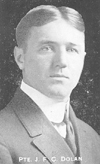
Private John Frederick Coleman Dolan, son of James and Katherine Dolan, was born at Fredericton on July 23, 1890. His early education was gained at Saint Dunstan's School and he later graduated from the High School, Fredericton, in 1907. The same year he entered the University to study Civil Engineering. During his College and High School career, Private Dolan was a sporting enthusiast and athlete. He captained both the football and hockey teams while at High School, and was a member of several University of New Brunswick football, hockey and basketball teams, being a member of the star team which toured Upper Canada. He also later played baseball professionally in the New Brunswick and Maine League.
In religion a Roman Catholic, he was a prominent member of St. Dunstan's choir. He also was a clever amateur thespian, taking part in numerous local and college plays. Before enlisting he was attached as a surveyor to Residency No.2 of the Valley Railroad Survey, and was connected with other lines of his profession in New Brunswick.
Private Dolan enlisted on November 11, 1914, with the 25th Overseas Battalion, but, before leaving Canada, transferred to the 6th Canadian Mounted Rifles. In England, he transferred to the 4th Canadian Mounted Rifles and served continuously in the trenches until the Battle of Ypres, June 2, 1916, when he was listed among the "missing." His family has not heard from him since, but they have not altogether given up hope of his still being alive, although every effort to locate him through the War Office has met with no success.

George B. MacDonell Fraser was the youngest son of the late George B. Fraser, barrister, etc., of Chatham, N. B., and Blanche, daughter of Dr. Brydone-Jack, a graduate of Aberdeen University, and for many years President of the University of New Brunswick.
"Mac" was born at Chatham, June 28, 1894, and was educated in the public schools of the town, matriculating from the Grammar School to the University in 1911. In May, 1915, he was graduated with the degree C.E., in absentia, for he was at the front in France.
While an undergraduate, he was employed in the Public Works Department three summers, - two in Chatham, N.B., the other in Quebec.
In November, 1914, he and many of his classmates joined the 23rd Field Battery and trained in Fredericton till February, 1915, when he sailed in the "Megantic" for England. In the following May, "Mac" went to France in a reinforcement to the 8th Battery under Colonel Anderson, was wounded in October, 1916, and invalided to England for several months. Returning to France in May, 1917, he was transferred to the 5th Battery, and fell in the Battle of Vimy Ridge, July 23, 1917.
He had seen much fighting on the Somme, both as a member of the 8th and afterwards of the 5th Battery, and his great coolness, dash, and courage were everywhere remarked.
"A good soldier and comrade; even-tempered, cool and brave under fire; jolly and unselfish," writes a companion. Another says: "Mac stood true under the supremest tests of manhood." Again: "All who knew him loved him for his constant cheerfulness and devotion to duty." "No better gun layer or finer man in the Battery than Mac Fraser," adds another.
He was buried in Aux Ritz Military Cemetery, Davons, near Albert.
His eldest brother, Lieutenant Archibald Brydone Fraser, of the 72nd Seaforth Highlanders, Vancouver, was killed in the Battle of the Somme, November 2, 1916, and buried in the Albert Communal Cemetery.

Charles Edward Freeze, the youngest son of J. Arthur Freeze of the town of Sussex, Judge of Probate, and the late Mary Dawson Freeze, was born at Sussex, February 26, 1891, and was educated at the Sussex Grammar School. He entered the University of New Brunswick as a Freshman in the autumn of 1910, but left before the completion of the term to enter the Bank of Nova Scotia at Sussex, where he remained about a year. He then went to Montreal and engaged in the business of advertising, becoming prominently connected with some of the leading business houses there.
In the autumn of 1915 he left Montreal to enter the ranks of the 104th Overseas Battalion, then being raised in his native Province, and proceeded overseas with that Battalion in June, 1916. Being transferred later to the 13th Reserve Battalion, he was appointed an Instructor; which position he relinquished in order to proceed to France, where he entered the ranks of the 26th New Brunswick Batallion.
On April 7, 1918, he was dangerously wounded and transferred to the Canadian General Hospital at Etaples, France, where, after improving considerably, he died on the morning of May 20, 1918, immediately following the destruction of the hospital by the Hun air raid.

Melbourne R. C. Smith, the youngest son of Mr. and Mrs. Robert Smith, formerly of Oak Bay, N. B., was born on May 12, 1886. His elementary education was received in the public schools of the Province. In 1904 he graduated from the Provincial Normal School. After several years in the teaching profession, he entered the University of New Brunswick and graduated in Arts in 1910. Following a short course in the New Brunswick Military School he obtained a position in the Department of Agriculture, Ottawa. Two years later he moved to Winnipeg and graduated from the Law School of Manitoba University in 1916.
Immediately after graduation in law he enlisted with the 221st Battalion, Winnipeg, with the rank of Sergeant. Upon his arrival in England he was transferred to the 13th Canadian Reserve Battalion, reverting to the rank of private. In June, 1917, he went to France as a member of the 78th Canadian Battalion. He volunteered for scouting duty, and at the Battle of Passchendaele, October 30, 1917, was severely wounded in the shoulder. He was carried to the dressing station, and, while waiting to have his wounds dressed, was instantly killed by a bursting shell. He is buried in Tyne-Cott Military Cemetery, in the village of Gravenstafel, just northeast of Ypres.
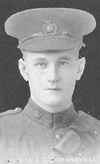
Joseph Clarke Sommerville, the eldest son of Mr. and Mrs. T. H. Sommerville, was born at Saint John, N. B., on June 22, 1899. His early education was obtained at the schools in his native city. While at High School his athletic ability won him a place on several football and basketball teams. He was prominent in the activities of the St. John Y. M. C. A., and St. David's Presbyterian Church.
In 1916, after completing Grade XII at Saint John High School, he entered the University as a member of the Sophomore Class. Here Clarke was universally regarded as a brilliant student, a good athlete, and as an upright, clean-living young man. He was captain of the Sophomore Basketball and a member of the University Football Team.
On November 29, 1916, he enlisted with the 9th Siege Battery stationed at Partridge Island, N.B., being at time only 17 years of age. He went overseas in December, 1917. In June, 1918, after completing his training in England, he joined the 12th Siege Battery in France. While fighting with that unit, he received wounds, which proved fatal. His death occurred in the hospital a few days later on October 3, 1918. Letters recently received from his comrades overseas speak very highly of how he performed his duties and of his life at the front.
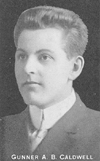
Arthur Beverly Caldwell, the eldest son of the late John and R. H. Caldwell, was born on May 22, 1896, at New Canaan, near Havelock, Kings County, N.B. He received his early education at the Canaan Road School and Petitcodiac Superior School. He entered the Provincial Normal School, in Fredericton, in the fall of 1912. After his course there, he taught school for a short time. Later he graduated from Fredericton High School.
He entered UNB as a freshman in the fall of 1914. While at the university, he took a great interest in the various student activities. In his sophomore year, he held the offices of secretary of the Students' Association and vice-president of the Debating Society. He was an enthusiastic football and basketball player. After completing his sophomore year, he enlisted in the 9th Siege Battery and was given the rank of sergeant. In August of the same year, while taking a heavy artillery course in Halifax, he developed typhoid fever.
Such was his eagerness to return to his duties, he did not allow himself time to recover fully from the effects of his illness. A short time after returning to Saint John, he developed pleurisy and finally tuberculosis. He was sent to Lake Edward Sanitorium in Quebec. In November, 1917, he was returned to his old home at Havelock, where he passed away on March 17, 1918. He was buried at Havelock.

Charles E. Kingdon Jones was born in Saint John, N. B., on September 26, 1889, the son of Charles D. and Jane McNutt Jones. Kingdon was educated at Rothesay College, and entered McGill University, which he attended for a year. He was then matriculated into UNB and graduated in 1912 with a bachelor of arts degree.
Becoming a member of the staff of a geological survey party, he spent one summer afield in Nova Scotia, and in December, was appointed to a permanent position in the Department of the Interior, in Ottawa. In the autumn of 1916, he entered the Kingston Military College to qualify in artillery, but, being injured by a fall from his horse, was obliged to discontinue the course. On recovering, he enlisted as a private in the Queen's Field Ambulance and went overseas in August, 1917. From Shorncliffe, he was transferred to Seaford and attached to the 7th Canadian Reserve Battalion, with which he went to France in April, 1918, and was then drafted into the 38th Canadian Battalion of Ottawa.
He fought at Amiens, from August 8 to 15; at Arras, on August 28; Drocourt on September 2; and at Douai-Cambrai Road on September 29, where he fell in action. The gallant 38th was nearly annihilated in this fierce struggle, in which 10 German divisions, with three others in reserve, were utterly routed by four Canadian divisions.
Lt. Crowell writes: "At the time of his death he was acting as a section commander, his senior non-com. having been killed or wounded. He was discharging the duties devolving upon him with admirable coolness and intrepidity, giving an example of high courage to the men under him. By his death, we lost a valuable man, one who had always exhibited the finest qualities of a soldier and of Canadian manhood."
He was buried in the cemetery of Bourlon Village, which stands on the edge of Bourlon Wood, from which his battalion had assisted in sweeping the Huns a few days before.
Lt. Austin Russell Murray, eldest son of Dr. D. Murray, of Campbellton, N.B., was born in Campbellton on April 16, 1894, and received his early education at Campbellton High School, from which he graduated in the year 1912 and was class historian of that year.
While attending school, he took a course in signalling under Sergeant Lowe, where he led his class and obtained a Grade A certificate. He also studied photography and telegraphy, and became quite proficient in both. After leaving school, he took a course in practical engineering in Boston and subsequently studied in the engineering department at UNB in Fredericton.
As soon as war was declared, he was anxious to enlist for overseas service at once, but owing to the illness of his mother, who died very shortly afterwards, his plans for the time being had to be abandoned. He realized, however, that he had a duty to perform for his country, and in view of his previous training, especially in engineering, he felt that he could do his part better and be of more service to his country in the artillery than anywhere else. In order to qualify for that branch of military service, he took a course at the Royal School of Artillery at Kingston, O.N., where he obtained his commission as a lieutenant.
Shortly afterwards, through the authority of Maj. Gen. Rutherford, of Halifax, N.S., on the recommendation of Maj. Ringwood and Capt. Stacey, of Kingston, O.N. (two of his former instructors), he obtained an appointment with the 5th Artillery Brigade, then training at Sewell Camp, Manitoba, known as the ‘Crack Brigade of the West.’
He joined this brigade in Montreal in the early part of August, 1915, just as the brigade was en route to England. He remained in England about two weeks, during which time he taught squad drill and gave instruction in gunnery to a section of the brigade, besides attending evening lectures given by officers who had returned from the firing line. He was then subjected to a searching examination in the several branches of field artillery, after which he was selected, with three other officers of his brigade, to go immediately to the firing line in France and thence to Belgium, where he arrived about the middle of September (just five weeks from the time he left home). On arriving in Belgium, he joined the 12th Battery, 3rd Brigade, Canadian Field Artillery, with the First Canadian Division, as forward observation officer and sectional battery commander.
He was in the firing line around Ypres and other points along the Western front for nine months, during which time artillery bombardments were almost continuous. He was slightly wounded several times by shell explosions and was one week in the hospital, but nothing daunting, he immediately returned to his post of duty, where he continued to direct his battery, until he was killed in action on June 16, 1916, at age 22, and was buried with military honours in Reninghelst New Military Cemetery in Belgium.
In writing home and to other friends from time to time, he always stated that whatever the outcome might be, he was pleased that he enlisted in the service of his country, to help in the struggle for liberty, justice and righteousness against despotism, treachery and inhumanity.